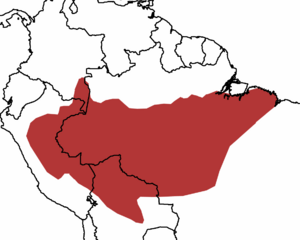Razor-billed curassow facts for kids
Quick facts for kids Razor-billed curassow |
|
|---|---|
 |
|
| Conservation status | |
| Scientific classification | |
| Genus: |
Mitu
|
| Species: |
tuberosum
|
 |
|
| Distribution of the razor-billed curassow | |
| Synonyms | |
|
Crax tuberosa (Spix, 1825) |
|
The razor-billed curassow (Mitu tuberosum) is a special type of bird. It belongs to a family of birds called Cracidae, which includes chachalacas, guans, and other curassows. You can find this bird in countries like Bolivia, Brazil, Colombia, and Peru.
Contents
About the Razor-billed Curassow
This bird was once thought to be part of a different bird group called Crax. But scientists used genetic information to confirm it belongs in the Mitu group. For a while, it was even considered a type of Alagoas curassow. Now, these two are known as "sister species," meaning they are very closely related. The razor-billed curassow is unique and doesn't have any different types or subspecies.
What Does It Look Like?
The razor-billed curassow is a fairly large bird, growing to be about 83 to 89 centimeters (about 3 feet) long. Males can weigh around 3.8 kilograms (about 8.5 pounds). Most of its feathers are black with a shiny purplish-blue color.
- Its lower belly and the feathers under its tail are a chestnut (reddish-brown) color.
- The tips of its tail feathers are white.
- It has a tall, messy-looking crest of feathers on its head.
- The bird's most noticeable feature is its large, bright red beak. It's flat on the sides, which is why it's called "razor-billed."
Where Do They Live?
You can find the razor-billed curassow in many parts of the Amazon rainforest. Most of them live south of the Amazon River. This includes eastern Peru, northern Bolivia, and northern Brazil, all the way to the Atlantic Ocean. Some are also found north of the Amazon River. This includes southeastern Colombia, a tiny part of northeastern Peru, and Brazil up to the Rio Negro.
These birds live in evergreen forests, which are forests that stay green all year. They prefer "terra firme" forests, which are on higher ground. But they also live in "gallery" forests (along rivers) and "várzea" forests (which flood seasonally). They also like areas near lakes and streams. They can live from sea level up to about 1,350 meters (4,400 feet) high.
How Do They Behave?
What Do They Eat?
The razor-billed curassow usually looks for food alone or in pairs. They search on the ground in the forest. Their main food is fallen fruits. They also eat leaves, insects, fungi (like mushrooms), and small vertebrates (animals with backbones).
Reproduction and Life Cycle
Sometimes, a male razor-billed curassow might mate with more than one female (this is called polygyny). In northern Peru, their nesting season is from November to February. One nest was described as a "perfect round cup" made from branches, vines, and leaves. A female usually lays two or three eggs at a time.
What Sounds Do They Make?
The song of the razor-billed curassow is a series of deep, booming sounds. The first three notes rise, and the last two are slightly higher. It sounds like: BMMM mmMMM... mmMMM'BMMM-BMMM. Sometimes, after a pause, they make a sharp BMM! sound. They sing from a high spot at any time of day, but most often before and at dawn. They sing more during the breeding season. Their other calls include rising whistles, popping sounds, and soft pweet calls.
What is Their Status?
The IUCN (International Union for Conservation of Nature) has listed the razor-billed curassow as a species of "Least Concern." This means they are not currently in immediate danger of disappearing. They live across a very large area. However, scientists don't know exactly how many of these birds there are. Their numbers are thought to be going down. This is mainly because people hunt them a lot.
See also
 In Spanish: Pavón pico de ají para niños
In Spanish: Pavón pico de ají para niños


